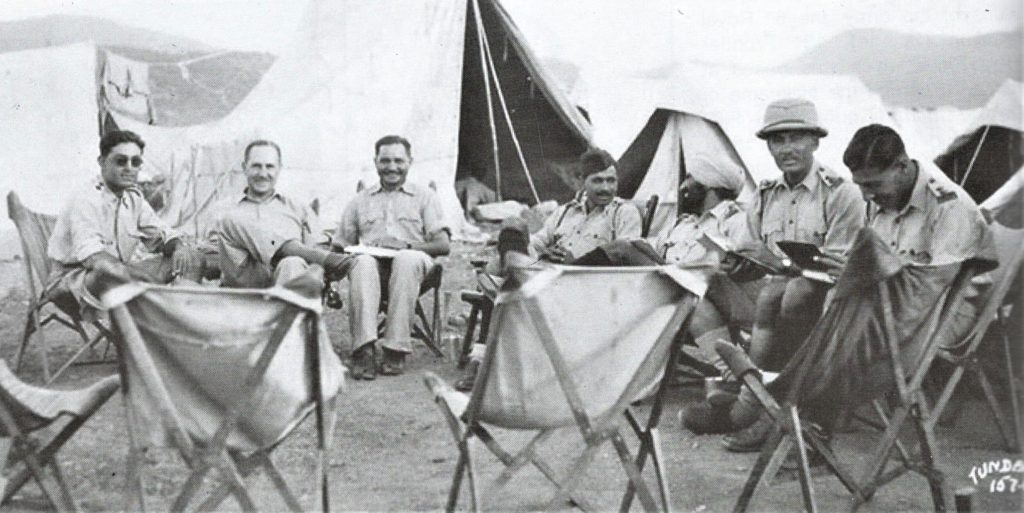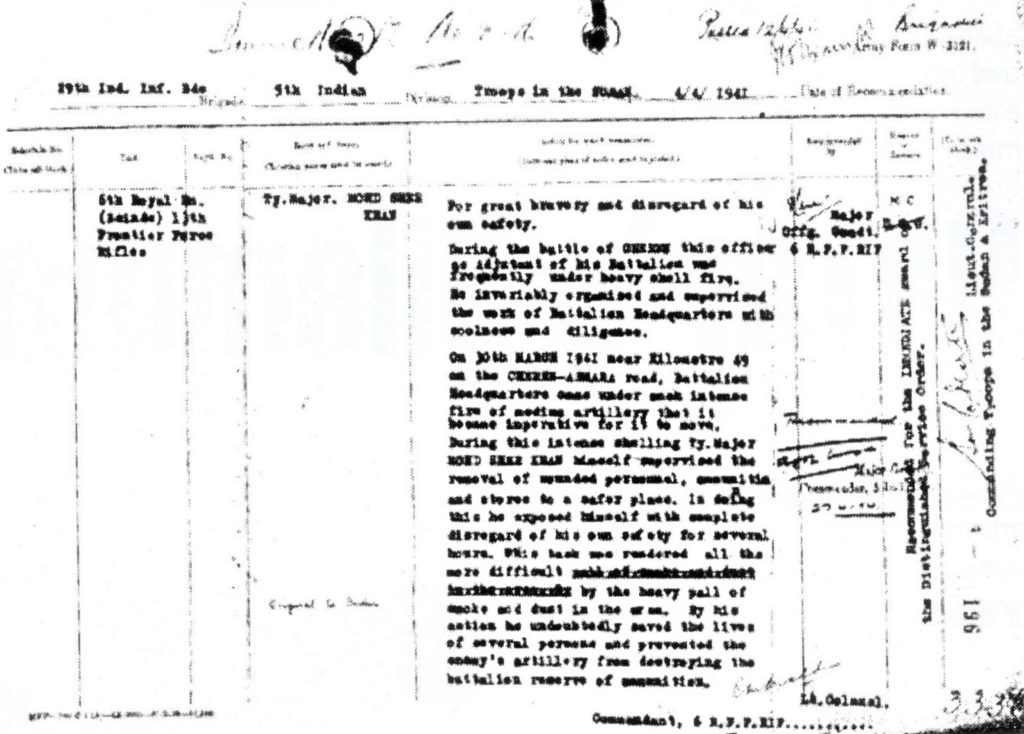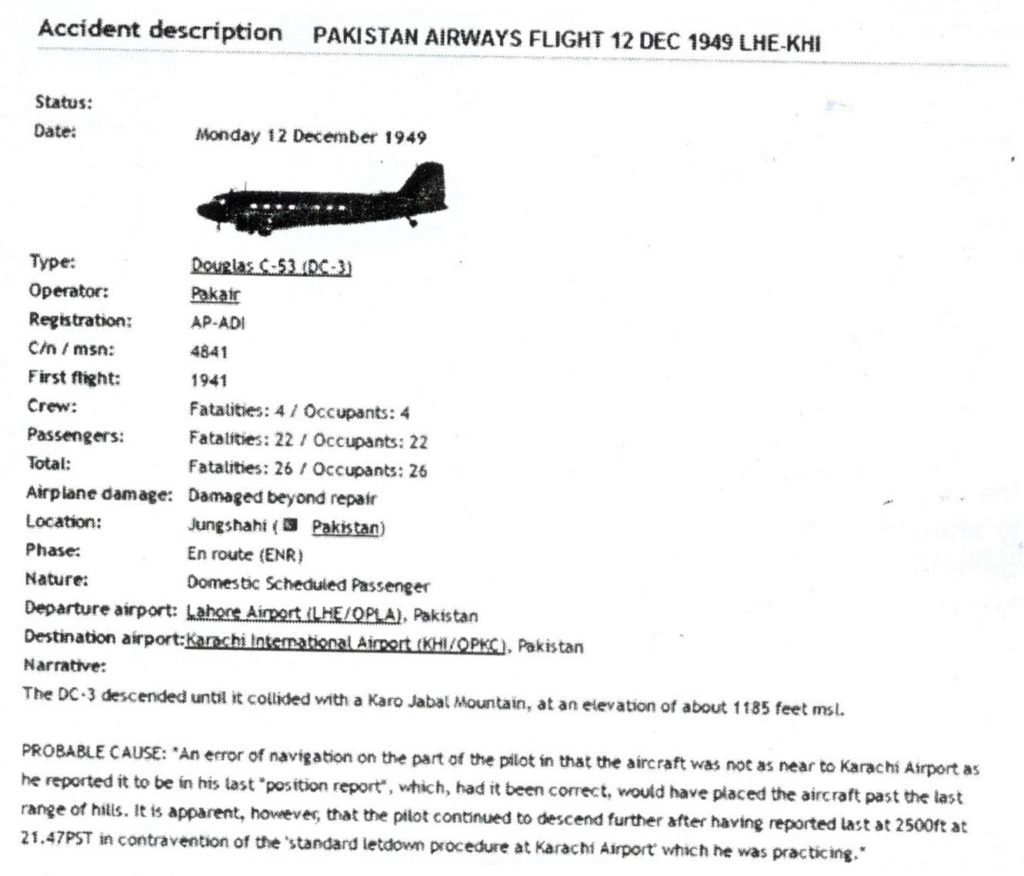Within two years of being formed, the fledgling Pakistan Army was stunned by the loss of two brilliant officers who were flying together to Karachi. Major General Iftikhar Khan (ex 3rd Cavalry), was en route to London to attend the course at the Royal College of Defence Studies and Brigadier Sher Khan (ex 6/13th FFR), who had recently been approved for promotion to Major General was heading for Washington. Neither of them had yet been allotted Pakistan Army numbers and both perished in an air crash on 12 December 1949.
The death of Brigadier Sher Khan must have been a tragic blow to his father, Subedar Major Khanezaman Khan. The Subedar had fought in France with the 107 Pioneer Battalion and awarded an IOM in the Battle of Somme in which he was wounded. Back in India, he served with 4/12th Frontier Force Regiment (54th Sikhs) and was invalided from the army.
Having witnessed firsthand the progress in Europe, he decided that his son must be educated abroad. Consequently he financed Sher Khan to be commissioned from Royal Military College at Sandhurst. It involved substantial expenditure since parents had to bear half the cost of obtaining a commission. Sher Khan passed out in 1932 and was posted to one of the elite battalions of the army, the 6th Royal Battalion (Scinde), 13th Frontier Force Rifles which was based at Poona.1 It carried the nickname of Garbar Unath (Troublesome Fifty Ninth). Prior to the reforms of 1922, its designation was 59th Sikhs and it had a reputation of always being up to some mischief.2 Nazir Ahmad who was one of the early Major Generals of the Pakistan Army was also commissioned into 6/13th but got involved in the Rawalpindi Conspiracy Case. The other Muslim officers commissioned in the same batch were K. M. Sheikh who joined 4/12th FFR, Adam Khan, a Pakhtoon from the Babori tribe who joined 2/1st Punjab; and (Tommy) Massaud Khan who joined 7th Light Cavalry and commanded 11th Cavalry during the First Kashmir War.

Sher Khan was promoted lieutenant in 1934 and his baptism of fire came two years later during the Waziristan Campaign of 1936-39. Also baptized was Lt. Muhammad Musa who was commissioned into the 6/13th in 1935 and ultimately became the C-in-C of the Pakistan Army. The battalion was commanded by Dudley Russel, nicknamed Pasha because of his bushy black mustache, swagger stick and confident manner. Russell Pasha was a highly decorated officer with DSO and MC. He was originally from 3/19th Hyderabad Regiment where he served a long stint and transferred to 6/13th RFFR in 1935. 6/13th RFFR formed part of the column known as Razcol, which marched out of Razmak into the Khaisora Valley in Nov 1936. The first three days passed without incidence, but on the fourth day the column came under fire while traversing a narrow valley about 16 km short of the objective of Bichhe Kashkai. Intense fighting ensued and it had to fight its way through to the village to link up with the Bannu Brigade. However since the supply situation became desperate and casualties mounted, both the columns had to withdraw to Mir Ali with the picquets and rearguard heavily engaged on numerous occasions. The two brigades suffered 107 casualties. In addition to Sher Khan, many others were also baptized including Muhammad Musa, Akbar Khan, Muhammad Yusuf, Anant Singh Pathania, Shaukat Ali Shah and Mohindar Singh Chopra.
Promotions in the army were slow and it took six years for Sher Khan to advance to a captain in 1940. By now the battalion was based at Secunderabad and was placed under the 5th Indian Division which was formed at the same station in May 1940. The first officer to arrive at the new divisional headquarters was the G.S.O.1, Colonel F. W. Messervy, who hurried there from command of the 13th Lancers. Messervy subsequently commanded Gazelle Force and an infantry brigade in East Africa, the 4th Indian Division in North Africa, the British 7th Armoured Division in the Battle of Ghazala, a corps in Burma and finally the Pakistan Army at Independence. He was known as the ‘Bearded Man’ because he tended not to shave in battle.

In September 1940, the division was shipped overseas to contest the Italian occupation of Sudan and Eretria, and was joined by the 4th Indian Division which had already won its laurels in Wavell’s campaign in North Africa. The culmination of the campaign in East Africa was the famous Battle at Keren which the Italian’s stubbornly defended. It was one of the few occasions on which they really fought with tenacity and fervor, particularly the regular troops such as Savoia Grenadiers, Alpini, and Bersaglieri who were proud of their resistance. Ultimately the Italians were forced to withdraw to Asmara and were pursued by the 5th Indian Division along a difficult road carved out of the hillsides that was mined and blocked at a number of places. Continuous harassing fire by the Italian artillery caused much destruction and the road was often jammed by casualties in men and vehicles.
On 30 Mar 1941, as the advance approached defile 3 km short of the village of Ad Taclesan, 6/13th FFR came under intense artillery fire. As a temporary major, Sher Khan was the adjutant and the battalion headquarters was located near Kilometer 49. It was here that he earned his Military Cross (MC). His citation records:
During this intense shelling T/Major MOHD SHER KHAN, himself supervised the removal of wounded personnel, ammunition, and stores to a safer place. In doing this, he exposed himself with complete disregard of his own safety for several hours. This task was rendered all the more difficult by the heavy pall of smoke and dust in the area. By his action, he undoubtedly saved the lives of several persons and prevented the enemy’s artillery from destroying the Battalion reserve of ammunition.
According to the citation, this wasn’t the first time that Sher Khan had placed his life at risk under intense shelling. It records that:

During the battle of Cheren (Keren), this officer as Adjutant of his Battalion was frequently under heavy shellfire. He invariably organized and supervised the work of Battalion Headquarters with coolness and diligence.
The officer was recommended for a DSO but awarded a MC.3 Two months after the action at Milestone 49, Sher Khan proceeded to Quetta to attend the Staff Course and passed on the duties of adjutant to Kashmir Singh Katoch.4 While Sher Khan was at the Staff College, his younger brother, Bahadur Sher was granted an emergency commission from IMA Dera Dun in Dec 1941. He followed Sher Khan into the 6/13th FFR and two years later in December 1943 while commanding a company in the assault across the River Moro in Italy, he was also awarded a MC. By this time, Sher Khan was serving as brigade major of the Kohat Brigade. In February 1945, he was promoted to command 16/13th Frontier Force Rifles which placed him amongst the first Indian officers to command battalions. The battalion was a wartime raising and was with the Wana Brigade since 1943. In early1946, Sher Khan brought the battalion to Wah near Rawalpindi, where it was disbanded and he was promoted to an acting brigadier and given command of an infantry brigade. At Independence, Sher Khan was appointed as the first Director of Military Intelligence (DMI) by Gen Messervy who was aware of his professional capabilities since the two had served in the 5th Indian Division in East Africa.

Sher Khan held the post of DMI for six months and then was appointed as Director Military Operations (DMO). In both these key posts he was closely involved in the Kashmir Operations whose main driving force was Brig Akbar Khan, DSO (code name Gen Tariq), who was a fellow regiment officer and had been commissioned into 6/13th FFR a year after Sher Khan. A separate operations room under the DMO had been established for the control and conduct of the operations at Rawalpindi. It was located outside GHQ at Bungalow No. 201, Murree Road, just short of its junction with the Rawalpindi Mall. It had a staff of around 12 and also stocked arms and ammo including 3 inch mortars for distribution to the Azad Forces. Gen Gracey who was now the C-in-C used to visit it in civilian clothes to be briefed by Brigadier Sher Khan. Following Independence, officers were rapidly promoted and by the end of 1948, Sher Khan was approved for the rank of Major General and designated to command 7th Division. However before taking command, he was to accompany the Foreign Minister of Pakistan who was going to the UN in Breton Woods, USA, to speak on the issue of Kashmir after the ceasefire.

Maj Gen Iftikhar who was commanding 10 Division in Lahore was being groomed as the first Pakistani C-in-C and detailed to attend the course at the Royal College of Defence Studies. The U.S. Military Attaché in Pakistan had a very high opinion of Iftikhar and also considered Sher Khan as the ‘best mind’ in the Pakistan Army with a ‘balanced personality’. He was of the view that after the tenure of Iftikhar, Sher Khan may succeed him as C-in-C. An evening before leaving Rawalpindi Sher Khan talked Iftikhar out of going by train to Karachi and instead joining him on the Pak Air flight from Lahore. Founded in 1948, Pak Air was a forerunner of the Pakistan International Airlines and its safety record was poor. It had already lost two aircrafts; one at Basra and the other near Vehari in Southern Punjab just 16 days prior to the crash in which all 21 passengers and crew had perished.
The flight to Karachi was aboard a Douglas DC-3 with the Registration Number AP-ADI. The aircraft was built in 1941 and probably flew a large number of missions during the Second World War from airfields in Bengal and Orissa to China over the ‘hump’. At the end of the war many aircrafts were sold to private companies at throw-away prices. It departed late on a four hours evening flight and 30 nautical miles short of Karachi, collided with the Karo Jabal Hills near Jungshahiat at an elevation of about 1185ft above mean sea level. According to the crash report, the probable cause was: “An error of navigation on the part of the pilot in that the aircraft was not as near to Karachi Airport as he reported it to be in his last “position report”, which had it been correct, would have placed the aircraft past the last range of hills.” All 26 passengers and crew perished and two days later, under instructions from the Ministry of Defence, Pak Air suspended all their services for an indefinite period of time.

Iftikhar was buried in the family graveyard in Faisalabad and the body of Sher Khan was flown to Peshawar where it was received by his relatives (his father had died earlier), as well as Major General Ayub Khan (then serving as Adjutant General), and Brigadier Habibullah Khan Khattak, commanding 100th Peshawar Brigade.5 He left behind a son and three daughters one of whom married Reza Kuli, the son of Lt. General Habibullah and the other married Javed Burki, the son of Lt. General Wajid Ali Burki. His son Aftab Ahmad Khan was at top of merit list at PMA and sent to Sandhurst, thus becoming member of a small group of father and son duo attending Sandhurst. He was later inducted in civil service and retired as Federal Secretary.

Author’s Analysis of the Air Crash Report
The standard letdown procedure at Karachi Airport was to approach the directional beacon located close to the main runway at 2500ft before descending and aligning for landing. In his last report which was only 30 nautical miles from the airport, the height stated by the pilot was 2500ft i.e. exactly the height required for the letdown procedure. The report states that “It is apparent, however, that the pilot continued to descend further after having reported last at 2500ft at 21.47 PST in contravention of the ‘standard letdown procedure at Karachi Airport’ which he was practicing.”

The report presumes that the descent was a deliberate act by the pilot in violation of the procedure. However that may not have been so. What if some technical problem had suddenly developed in the aircraft after the last report due to which it made a sudden descent and crashed at 1185ft? On this possibility the report is silent. If one now factors in the secondary cause of the Pak Air flight that disintegrated and crashed in flames near Vehari just 16 days earlier, it lends credibility to the chances of a technical failure. The secondary cause was “a generally low standard of maintenance due to lack of tools, spares, adequate lighting, hurried workmanship, and inexperience in lower staff grades”. Pak Air did not have its own maintenance facilities. The Government of Pakistan along with Orient Airways and Pak Air had formed Pakistan Aviation Ltd to handle the maintenance of aircrafts for all three entities and the standard and facilities were rudimentary.

Acknowledgements
I want to thank Sushil Talwar for providing me the bio data and citation of Brig Sher Khan, and answering my numerous queries related to his career. My thanks to Brig Zahid Zaman, a nephew of Sher Khan for photographs of the brigadier and details of his life. The operations of 6/13th RFFR in Eretria have been extracted from ‘Ball of Fire, the 5th Indian Division in the Second World War’. I would also like to thank my old friend Ijaz Haq who has a life time of experience flying for PIA and Emirates, for helping me analyze the crash reports.
End Notes
1 It now forms part of the Pakistan Army as the 1st Battalion Frontier Force Regiment.
2 In the Indian cavalry the regiment that corresponded to the Garbar Unnath was 5th Probyn’s Horse whose nick name was Problem Horse.
3 Two other officers of the battalion, Anant Singh Pathania and Sadiqullah had been awarded MCs a few days earlier at the famous Battle of Karen.
4 Katoch was a fine officer. In the battle of Monte Casino, the Pathan Company of 6/13th RFFR was severely mauled by well-placed machine gun nests. Katoch led his Dogra Company to clear many machine gun nests to avenge the deaths of his Pathan comrades for which he was also awarded an MC.
5 Following Sher Khan’s death, his promotion to Major General was certified by the government and his widow drew the pension entitled to this rank





